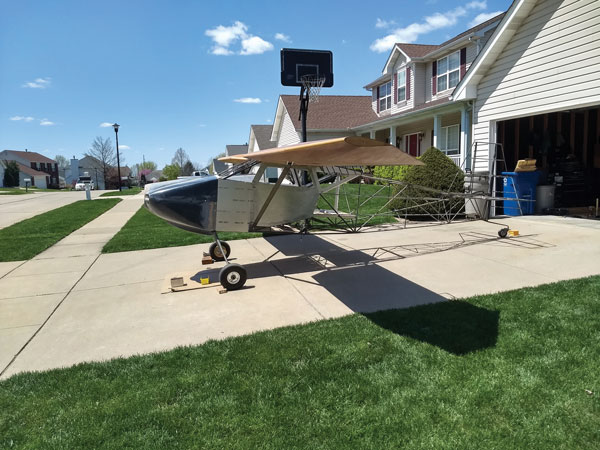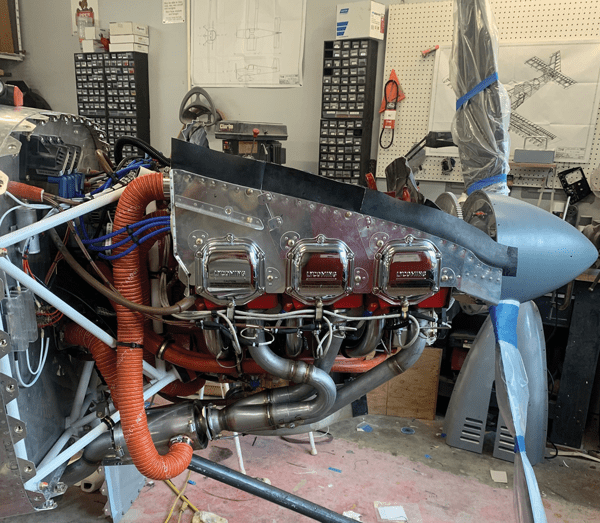
By Michael D. Wilson, EAA 273070
This piece originally ran in the January 2024 issue of EAA Sport Aviation magazine.
My 30-year adventure building a Wittman Tailwind finally culminated in its first flight June 10, 2023. What a journey. It had been a dream of mine to build an airplane since scouring my dad’s Popular Mechanics coverage of Oshkosh when I was about 11 years old. When people would ask me when I planned to finish building the airplane, I half-jokingly said, “By the time I retire.” Well, I haven’t retired yet, so technically I beat my deadline. I have thoroughly enjoyed the building process. I obviously didn’t work on it steadily, but the project was always in the back of my mind, and I liked having a project to turn to whenever I had the urge to build. During the build, I owned several flying airplanes including an Aeronca Chief, Acro Sport II, and Davis DA-2A to satisfy my need to fly, and the skills learned during building were put to use maintaining these other aircraft.
The Tailwind was always on my short list of airplanes to build. Every pilot that I talked to about the Tailwind had good things to say about it, and reading Wilson Werhan’s May 1987 article in EAA Sport Aviation cinched it. Wilson was describing his first 250 hours in four years of flying. I had seen many homebuilts being listed for sale with few hours. Here was a design that was actually getting used. I also liked the idea of learning traditional tube and fabric construction techniques.

I’ve told people that building an airplane is an opportunity to learn. Through this process I’ve learned: oxyacetylene welding, sheet metal work, fiberglass, woodwork, fabric covering, upholstery, engine overhaul, and more. Aside from help sheeting the wings and hauling the airplane and engine out of the basement, I built the airplane entirely by myself. But I had a lot of help with questions answered by fellow Tailwind builders I met at Oshkosh, at the Tailwind gatherings at Baraboo and now Watertown, Wisconsin, and also on the Tailwind online forum. These fellow builders are an invaluable source of information, especially since the plans only cover the basic airframe so all of the finishing details are left to the builder.

The airplane is powered by a Lycoming O-320 that I converted to 160 hp. For ignition the airplane has one standard magneto and one P-Mag. The propeller is a ground-adjustable unit from Whirlwind Propellers. The avionics are based around a GRT Sport EX electronic flight instrument system (EFIS) and GRT engine information system, an MGL V16 comm, and Trig transponder. Each of these units communicate with the EFIS. I spent many hours using the EAA SOLIDWORKS member benefit to model the instrument panel. Once I was satisfied with the layout, I sent the CAD files to FrontPanelExpress.com where they cut and engraved the panel in black anodized aluminum with white infill. The price was reasonable (less than $300). The wingtip nav, position, and strobe lights are LED units of my own design. For paint and fabric I used the Stewart Systems process.

I was more than a little bit excited on my first test flight (the monitor on my watch showed that my heart rate peaked at 150 bpm!). I had read the EAA Flight Test Manual and FAA’s Advisory Circular 90-89C, and then rehearsed the flight 100 times in my head. The flight went smoothly, and in subsequent flights I made adjustments to flaps, rudder trim, engine offset, and static port. Cruise speed is between 160-170 mph, and I’m hoping to gain a little more when I install wheelpants. I flew Phase I using the task-based option with the EAA Flight Test Cards and was able to bring the airplane to EAA AirVenture Oshkosh this year for the 70th anniversary of the Tailwind. While at AirVenture I got to participate in the Tailwind homebuilders forum. After returning from Oshkosh, I was surprised to find out that I had won a Bronze Lindy! I never intended to build a showplane, just as clean an example as I could, keeping with Steve Wittman’s original intent of a simple, fast airplane.
Attention — Aircraft Builders and Restorers
We would love to share your story with your fellow EAA members in the pages of EAA Sport Aviation magazine, even if it’s a project that’s been completed for a while. Readers consistently rate the “What Our Members are Building/Restoring” section of the magazine as one of their favorites, so don’t miss the chance to show off your handiwork and inspire your peers to start or complete projects of their own. Learn more ->
Discover more from reviewer4you.com
Subscribe to get the latest posts to your email.




